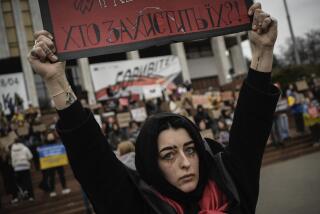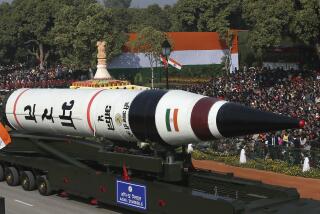Pakistan Retaliates in Incident With India
- Share via
ISLAMABAD, Pakistan — Pakistani troops fired a missile Wednesday at an Indian military aircraft in the second clash in two days along the countries’ disputed southern border.
Pakistani officials said they launched the surface-to-air missile when Indian jets invaded their airspace in the Badin region, where an Indian jet shot down a Pakistani surveillance plane the day before, killing all 16 crew members. Indian officials said the missile headed for a helicopter that was ferrying journalists to the crash site.
The missile missed, but it represented another ratcheting up of the tension along the Indo-Pakistani border. Also on Wednesday, Indian officials said their forces killed five Pakistanis while repulsing an assault on the disputed Siachen Glacier in Kashmir in the Himalayas.
The skirmishing follows 11 weeks of fighting between India and Pakistan in the Kashmir region. The fighting, which ended last month, left more than 1,000 people dead. India and Pakistan, which each tested nuclear weapons last year, have gone to war three times since 1947 without settling their territorial differences. Wednesday’s flare-up suggested that they might be sliding into a pattern of provocation and response that has typified their relations for more than half a century.
“The leaders of these two countries need to stop this before events get out of control,” said retired Pakistani Lt. Gen. Talat Masood.
The latest crisis began Tuesday when an Indian jet shot down a Pakistani reconnaissance plane over a stretch of marshland known as the Rann of Kutch.
Indian officials said they fired on the Pakistani plane when it invaded Indian airspace and responded aggressively to overtures by Indian aircraft.
Pakistani leaders said their plane was unarmed and on a routine training flight. They called the shoot-down “coldblooded murder.”
On Wednesday, Pakistan’s leaders placed the country’s armed forces on high alert and met to decide on a response.
“All provocations and violations of Pakistan’s airspace would be considered as hostile acts and given a befitting response,” a statement by the Defense Committee of the Cabinet said.
Indian officials said more than 20 Pakistani troops twice tried to capture an Indian post on the Siachen Glacier on Wednesday. The two countries have been fighting for control of Siachen, the world’s highest battlefield, undeterred by the severe cold and altitudes as high as 23,000 feet.
“I do not know anything about that,” said Lt. Col. Saulat Raza, a Pakistani military spokesman.
The two countries engaged in a public relations battle to prove that the downed Pakistani plane was on its side of the border when it went down. Both India and Pakistan displayed recovered wreckage.
Pakistani Brig. Rashid Qureshi accused the Indians of crossing the border overnight and dragging wreckage to the Indian side. A video broadcast in Pakistan purportedly showed Indian soldiers running with broken plane parts back across the border.
“Scampering like thieves,” Qureshi said.
Indian officials dismissed the charge. But Associated Press reported that Indian Air Marshal A.Y. Tipnis, head of the air force, acknowledged Wednesday that “a major part” of the wreckage was in Pakistan.
He said that the Pakistani plane could have been scouting possible invasion routes into India and that the pilots of the Indian interceptors feared that the plane was armed.
“In the event of an offensive, they could be looking for . . . the possible creeks, the possible channels through which they can come in,” Tipnis said at Naliya, an air base in the western state of Gujarat.
The aerial confrontation occurred over Sir Creek, a 60-mile-long estuary that forms the border. The creek’s shifting tides have been the subject of armed clashes between the two countries.
The United States urgently called on India and Pakistan to reinstitute a 1991 agreement under which aircraft must not fly within six miles of the border without advance notification.
Stephen Cohen, a scholar at the Brookings Institution in Washington, said the recent fighting in Kashmir may have left the armed forces of each country in a hair-trigger mode.
“In a heightened state of alert, the young officer will shoot first and ask questions later,” Cohen said. “The problem is that at the end of the road, you have nuclear weapons.”
Cohen said domestic politics in both India and Pakistan appeared to be driving tensions higher. The ruling Bharatiya Janata Party in India faces a national election next month, and Pakistani Prime Minister Nawaz Sharif is facing a public angry over military defeat and a collapsing economy.
“The hawks in each country are getting stronger,” said Masood, the retired Pakistani general.
More to Read
Sign up for Essential California
The most important California stories and recommendations in your inbox every morning.
You may occasionally receive promotional content from the Los Angeles Times.










